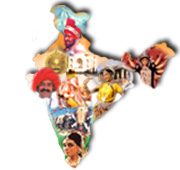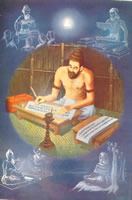|

India has an elusive quality that is part myth and part
legend. Its enigmatic persona invites curiosity and incredible
inquiry. It is in India that one can fully appreciate
the meaning of Rousseau's axiom, 'The life which is unexamined
is not worth living," for India answers every question
that is raised and raises new questions for every answer.
Utter the name India and images of mystery and adventure
are conjured up. Thinking of India is an emotional experience
that has an incredible capacity to awaken dormant compassion
and humility in its onlookers. Being in India is the closest
thing to spirituality one can find on earth. Mystical
and mythical, India is an engaging experience of sense
and sensibilities; beyond space and time.
Providing an array of sights; its profound beauty truly
lies "in the eye of the beholder." It has been said that
India remains unchanged while it has changed others. Those
who witness its beauty are undoubtedly changed forever.
Overwhelming. India impresses like no other culture.
India is a mirage of infinite horizon-the closer one gets,
the farther it moves. Like a wanderlust journey of an
undetermined destination, it is a mythical land of perceptive
depths and expansive dimensions. For millenniums it has
cradled ancient civilizations, witnessed celestial configurations,
constructed prodigious monuments, experienced benevolent
and ruthless traders, invaders and rulers and acquired
a unique petrified personalitv that is impossible to duplicate.
Some 5,000 years ago when much of the world was still
unexplored, India was alive with the advanced Indus Valley
Civilization at Mohen-jo-Daro and Harappa. The advanced
civilization that had multistory brick houses with bath
and sanitation drainage, wide roads, a rich philosophy
of life and a fully developed script that, like a mystery,
remains un-deciphered even to this day !
In earlier times, India was known as the golden bird.
Innumerable tales of her wealth and opulence gravitated
traders, travelers, raiders and rulers toward her who
came either for jewels, ivory, silks and spices or for
vast open land. The majestic stories told by returning
visitors gave an aura of mystery and excitement about
India to the rest of the world. Serving as an important
link to the trade routes between East and West, it brought
the Persians, the Greeks, the Arabs,
the Mughals and the Europeans, including the English,
to her door step. India embodies the idea of amelting
pot that has welcomed, nurtured and assimilated many
On Top of the Page
|
human races in the course of her 5000 year history. It
is a land of variety, pulsating and alive where landscape,
people and palaces permeate innate beauty to transform
it into a splendid mosaic of interesting patterns and
vibrant colors.
India is breathtaking. Attracting old and young alike,
it is therefore a curious blend of diverse religions,
languages regions, art, cuisine, costumes and customs.
The diverse Indian tapestry has maintained its brightness
in spite of its existence of 5000 years. The medieval
India was ruled by the Mughal Dynasty For over three hundred
years. For another two hundred years it was colonized
and ruled by the English. On August 15, 1947 India became
an independent democratic nation.
 Mahatma
Gandhi championed the philosophy of non-violence and non-cooperation
to energize and mobilize the freedom movement. Among thousands
who participated in the freedom struggle were: Motilal
Nehru and his son Jawaharlal Nehru, Sri Aurobindo Ghosh,
Subhash Chandra Bose and Sardar Vallabh Bhai Patel. Gandhi's
efforts to gain freedom through peaceful measures have
been adopted and practiced by many others: Nelson Mandela
and Late Martin Luther King, Jr., etc. For comparison,
Gandhi is respected in India as the Father of the Nation,
like George Washington in America. Mahatma
Gandhi championed the philosophy of non-violence and non-cooperation
to energize and mobilize the freedom movement. Among thousands
who participated in the freedom struggle were: Motilal
Nehru and his son Jawaharlal Nehru, Sri Aurobindo Ghosh,
Subhash Chandra Bose and Sardar Vallabh Bhai Patel. Gandhi's
efforts to gain freedom through peaceful measures have
been adopted and practiced by many others: Nelson Mandela
and Late Martin Luther King, Jr., etc. For comparison,
Gandhi is respected in India as the Father of the Nation,
like George Washington in America.
 As
the land of the Vedas; knowledge and wisdom, India has
long been linked to the philosophical wisdom and eternal
spiritual quest of human kind. Many scholars came from
far away to study at the Indian Universities of Nalanda
and Taxila with some 10,000 pupils. The Chinese Scholars,
Hiuen Tsang and Fahien visited in sixth and seventh CE,
Vasco De Gama and Marco Polo anchored their ships in 1400
and 1500 CE and Mark Twain, Eleanor Roosevelt, and Martin
Luther King, Jr. came in the late nineteenth and twentieth
centuries. As
the land of the Vedas; knowledge and wisdom, India has
long been linked to the philosophical wisdom and eternal
spiritual quest of human kind. Many scholars came from
far away to study at the Indian Universities of Nalanda
and Taxila with some 10,000 pupils. The Chinese Scholars,
Hiuen Tsang and Fahien visited in sixth and seventh CE,
Vasco De Gama and Marco Polo anchored their ships in 1400
and 1500 CE and Mark Twain, Eleanor Roosevelt, and Martin
Luther King, Jr. came in the late nineteenth and twentieth
centuries.
One of the questions that is most often asked is about
the source of the terms Hinduism and India. Interestingly,
their origins are geographical in nature. In ancient times,
people inhabited mainly the Northwest Sindh River region.
In the Persian Language, Sindh became Hind. The people
living in this region were called, Hindus and their philosophy,
Hinduism. In Greek, Sindh became Indus and from it came
India and Indian. With the passage of time; the terms
Hindu and Hinduism, India and Indians were extended to
the entire sub-continent.
India is a vast country, a subcontinent, a land of sun,
sand, snow and sea. Here, the snow-covered Himalayan ranges
stretch fifteen hundred miles from North to East and some
4200 miles of luscious and sandy beaches line the South.
To the East, it has hilly tea gardens and the town of
Chirapunji, which receives the highest rainfall in the
world, while the West houses a blazing desert of roaming
camels and nomads.
|